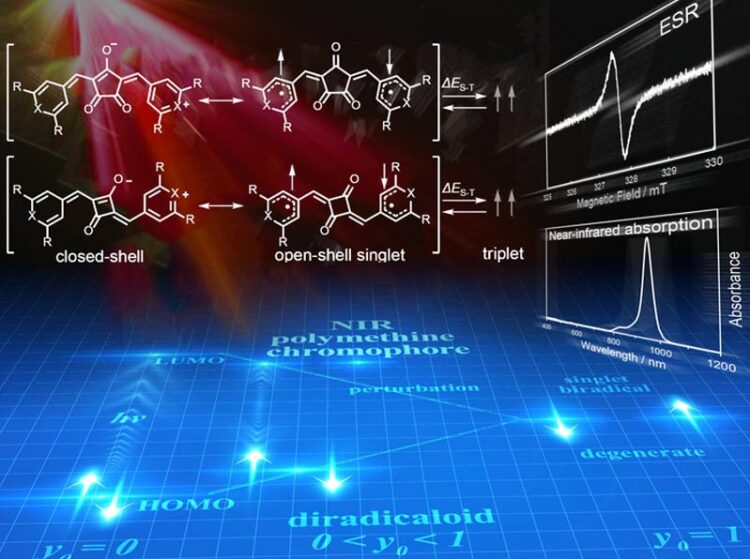Looking from different perspectives!

Illustration of properties and electronic structure of a near-infrared absorbing dye in an intermediate state between closed- and open-shell states
Credit: Takeshi Maeda, Osaka Metropolitan University
Proper electronic structure of near-infrared absorbing functional dyes discovered.
A big step toward the development of dyes with long-wavelength near-infrared absorption!
Near-infrared light, whose wavelength is longer than visible light, is invisible and can pass through many substances. Organic materials that efficiently absorb near-infrared light are essential for technological innovations that utilize near-infrared light, such as the dyes in the infrared blocking filters of smartphone cameras and security inks. These and many more technical applications make developing new dyes that can absorb longer wavelengths of near-infrared light desirable.
Previously, near-infrared absorbing organic materials were treated as closed-shell molecules without unpaired electrons. However, a joint research group led by Associate Professor Takeshi Maeda, Assistant Professor Daisuke Sakamaki, and Professor Hideki Fujiwara from Osaka Metropolitan University discovered that near-infrared absorbing oxocarbon-based dyes have an intermediate state between closed-shell and open-shell electronic configurations. They also found that as the wavelengths of near-infrared light absorbed increase, so does the contribution of open-shell forms in the dye.
“We have clarified the proper electronic structure of near-infrared absorbing oxocarbon-based dyes that are regarded as pure closed-shell molecules. We hope that this will lead to advances in the molecular design, properties, functions, and applications of near-infrared absorbing dyes and to the development of new near-infrared absorbing organic materials that be used in society,” Professor Takeshi Maeda concluded.
The results were published in Chemical Science on January 16, 2023, and was selected as 2023 Chemical Science HOT Article Collection.
Other authors on the paper include: graduate student Taishi Oka, Assistant Professor Naoya Suzuki, Professor Shigeyuki Yagi from Osaka Metropolitan University, Dr. Kenji Kamada from National Institute of Advanced Industrial Science and Technology, and Mr. Tatsuki Konishi.
About OMU
Osaka Metropolitan University is a new public university established in April 2022, formed by merger between Osaka City University and Osaka Prefecture University. For more research news visit https://www.omu.ac.jp/en/ or follow @OsakaMetUniv_en and #OMUScience.
Journal: Chemical Science
DOI: 10.1039/D2SC06612B
Method of Research: Experimental study
Subject of Research: Not applicable
Article Title: Unveiling a new aspect of oxocarbons: open-shell character of 4- and 5-membered oxocarbon derivatives showing near-infrared absorption
Article Publication Date: 16-Jan-2023
Media Contact
Yoshiko Tani
Osaka Metropolitan University
koho-ipro@ml.omu.ac.jp
Original Source
All latest news from the category: Materials Sciences
Materials management deals with the research, development, manufacturing and processing of raw and industrial materials. Key aspects here are biological and medical issues, which play an increasingly important role in this field.
innovations-report offers in-depth articles related to the development and application of materials and the structure and properties of new materials.
Newest articles

High-energy-density aqueous battery based on halogen multi-electron transfer
Traditional non-aqueous lithium-ion batteries have a high energy density, but their safety is compromised due to the flammable organic electrolytes they utilize. Aqueous batteries use water as the solvent for…

First-ever combined heart pump and pig kidney transplant
…gives new hope to patient with terminal illness. Surgeons at NYU Langone Health performed the first-ever combined mechanical heart pump and gene-edited pig kidney transplant surgery in a 54-year-old woman…

Biophysics: Testing how well biomarkers work
LMU researchers have developed a method to determine how reliably target proteins can be labeled using super-resolution fluorescence microscopy. Modern microscopy techniques make it possible to examine the inner workings…





















